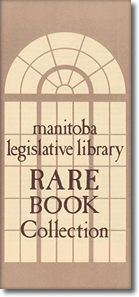Rare Books Collection
Scope and Highlights of the Rare Book Collection

pamphlet cover
Most books in the collection are related to Manitoba and the Canadian Northwest including books published in Manitoba and books published outside Manitoba about the province and its people. The Rare Book Collection is non-circulating. Some highlights are:
- Works by famous Manitobans such as Alexander Ross, Donald Gunn, Nellie McClung, and J.S. Woodsworth and the Bible belonging to Chief Peguis, friend of the Selkirk Settlers.
- Special pamphlet collections on such topics as the Riel Rebellion, the Winnipeg General Strike and the Manitoba School Question are a popular resource.
The Red River Library is a special collection of 350 volumes still remaining from the library that served the Selkirk Settlers. Officially founded in 1848, the Red River Library traces its origins to the beginnings of the Settlement when in 1812 Lord Selkirk sent out several books which he hoped would be used by the settlers as they established homes in the Red River Settlement. Several years later, the settlers inherited the library belonging to Peter Fidler of the Hudson's Bay Company.
Once including over 2500 volumes, the Library served the settlers and their descendants for many years, until a series of events led to its neglect and dispersal in the 1860's. Over the years, a number of inventories of the Library were made, making it possible to form an idea of its contents. Practical reference works in the fields of agriculture, history and law were selected to provide information for the settlers while biographical works and novels must have been enjoyed by those who valued reading in their leisure time. In an isolated community such as Red River, the settlers must have valued books about travel and geography, and there was a wide selection of such works available in the Library. Today, the 350 volumes remaining form a special part of the Rare Book collection. Because of their history, the books belonging to the Red River Library collection are not normally available for research purposes but are used for special displays.


